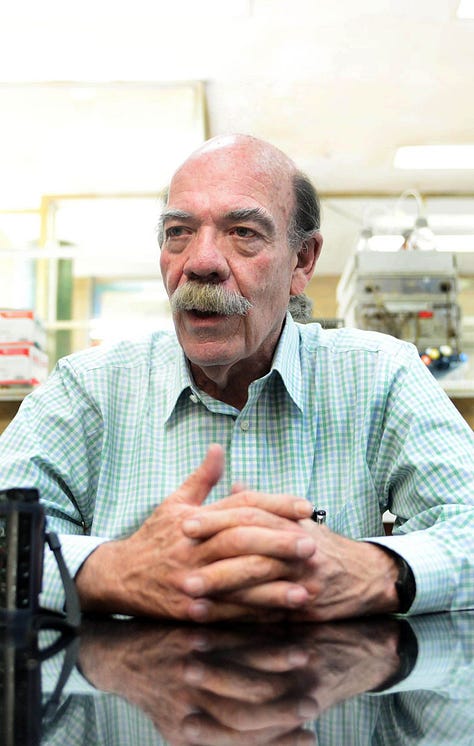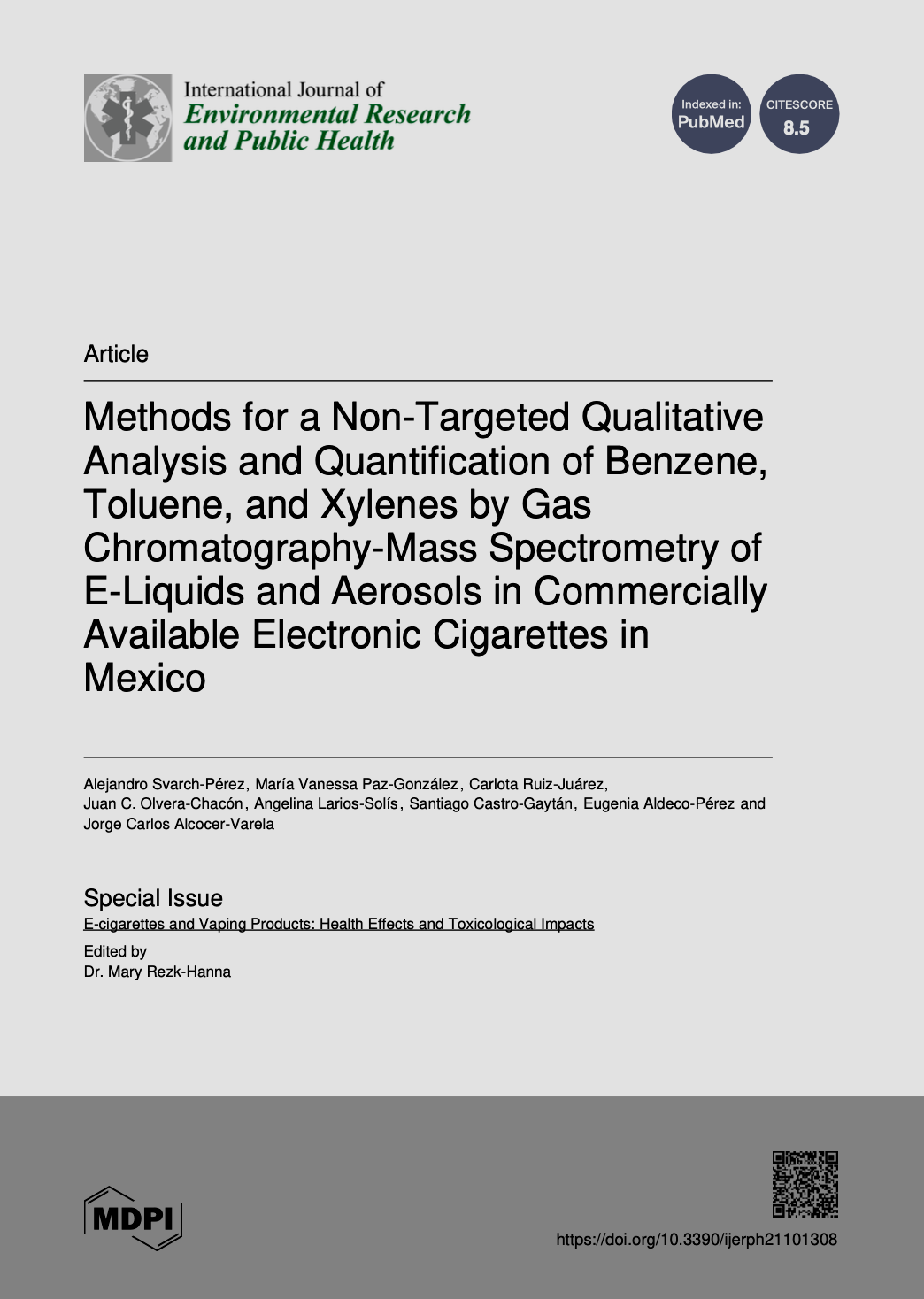When Rigor Collapses: Anatomy of a Flawed Study on Vaping and Toxic Exposure
And When Precision Strikes Back: A Scientific Autopsy by Sussman, Gómez-Ruiz, and Farsalinos Against the Machinery of Impact-Driven Science
Before it can be dismantled, a scientific falsehood must first appear solid. It must speak the language of graphs, wear the lab coat of authority, and circulate with a passport stamped by indexed journals.
That’s how a study published in the International Journal of Environmental Research and Public Health sought to gain global-alert status: the vapors from disposable e-cigarettes would contain levels of benzene, toluene, and xylene so high they would surpass — by a wide margin — both occupational safety thresholds and those found in traditional cigarette smoke. It sounded grave. It seemed irrefutable.
But it wasn’t. Beneath the technical armor were elementary conversion errors, incommensurable exposure scales, and comparisons as distorted as they were alarmist. What presented itself as science was a structure built on unstable premises, where rigor gave way to haste and doubt was displaced by rhetorical certainty.
Three scientists — two Mexicans and one Greek — pored over the data, with the patience of those who understand that science demands time and effort. They dismantled the study piece by piece, exposing not just the collapse of a single article but a deeper structural flaw: an editorial system willing to validate almost anything, so long as it arrives wrapped in urgency and dressed in good intentions.

In October 2024, the International Journal of Environmental Research and Public Health (IJERPH) published a study by Svarch-Pérez et al. analyzing twenty disposable electronic cigarette devices collected in Mexico City.
The article, with its technical and ambitious title — Methods for a Non-Targeted Qualitative Analysis and Quantification of Benzene, Toluene, and Xylenes by Gas Chromatography-Mass Spectrometry of E-Liquids and Aerosols in Commercially Available Electronic Cigarettes in Mexico — concluded that concentrations of benzene, toluene, and xylene (collectively known as BTX) in the liquids and aerosols examined far exceeded both the occupational exposure limits set by Cal/OSHA and the levels typically found in cigarette smoke.
The initial proposal — to quantify volatile aromatic hydrocarbons in widely available consumer products — appeared to be a legitimate contribution to environmental toxicology.
However, when subjected to the scrutiny of three independent experts of three experts — physicist Roberto A. Sussman of UNAM’s Institute of Nuclear Sciences, analytical chemist Humberto Gómez-Ruiz of the same university, and cardiologist and researcher Konstantinos Farsalinos from the University of Patras and the University of West Attica — the scientific foundation of the study collapsed.



Their analysis revealed not only controversial interpretations but also fundamental errors: a flawed conversion of exposure units, invalid comparisons across incompatible scales, and methodological omissions that would not withstand even basic peer review. These were not marginal oversights, but errors that compromise the article’s scientific validity at its core.
What could have been a legitimate public health warning became, instead, a cautionary tale — a demonstration of how scientific rhetoric, when untethered from technical rigor, can travel swiftly through editorial systems eager for impact. A kind of science driven more by the urgency of visibility than by the weight of evidence — science that enters the world unripe, like a tightrope walker stepping into thin air, convinced there is ground beneath.
Concentrations, Volumes, and a Gross Overestimation of BTX Compounds
As noted by physicist Dr. Roberto Sussman, the central flaw in the study by Svarch-Pérez et al. lies not only in the chemical analysis itself — already marked by inconsistencies — but in something even more elemental: how the authors calculated the concentrations of benzene, toluene, and xylene (collectively known as BTX), as reported in Table S1. It is on the basis of these figures that the authors claim BTX levels exceeded both Cal/OSHA's occupational exposure limits and the concentrations typically found in cigarette smoke.
According to their methodology, the authors report concentrations in μg/L (micrograms per liter) based on the number of puffs and the liquid volume declared on the packaging of each device. Crucially, the “L” in this equation refers not to air inhaled, but to the amount of e-liquid vaporized to produce the aerosol.
The error — subtle to the casual reader but devastating to any trained scientist — lies precisely here. Using the standard formula C = mass/volume, the authors performed correct arithmetic on an entirely flawed premise. They report values such as C = X μg/L, with X reaching up to 166,555. This would suggest that, for each liter of e-liquid vaporized, they found 166,555 micrograms of BTX. But they never vaporized a liter of e-liquid.
According to their own description, only two puffs were performed per device. Based on the specifications in the device packages, this corresponds to approximately 0.000002 liters of e-liquid, or two microliters. The math is simple: disposable devices typically contain 10 mL of e-liquid designed to deliver 10,000 puffs, which yields 0.001 mL per puff. Two puffs, therefore, amount to 0.002 mL, or two parts per million of a liter.
Claiming that such a minuscule amount of liquid could yield 166,555 μg of BTX is not just methodologically questionable — it is physically implausible. The only way to correct for this distortion would be to adjust all reported concentrations by a factor of 0.000002. In other words, the actual BTX levels, when scaled to the tested volume, are at least 100,000 times lower than what the study claims.
Surveys of regular vapers indicate an average daily consumption of 3 to 5 milliliters of e-liquid. At that rate, vaporizing 1 liter of e-liquid would require approximately 200 to 300 days of use — the equivalent of 7 to 10 months of regular vaping. The scale of the authors’ error becomes fully apparent: by analyzing just two puffs, they implicitly equated this negligible sample with tens of thousands of inhalations — roughly 40,000 to 60,000 puffs, according to user behavior data that estimate an average of 200 puffs per day.
As Dr. Roberto Sussman emphasizes, this assumption is not only flawed but also fundamentally absurd from both a physiological and toxicological perspective. “Even if they had converted the units correctly,” Sussman notes, “their error in calculating the liquid concentrations alone demolishes the entire article.”
But the problem doesn't stop there.
The unit μg/L is appropriate for expressing concentrations in liquids. Yet the authors used these values to make direct comparisons with respiratory safety thresholds, which are defined in terms of air concentrations, such as ppm (parts per million) or mg/m³ (milligrams per cubic meter). These refer to the mass of a compound dispersed in a given volume of air, not liquid.
To make a valid comparison with occupational exposure limits, one must consider the volume of air actually inhaled — whether it's the 0.5 liters of a single breath (known as tidal volume), the 20 m³ of air inhaled daily under low physical activity, or the 8 m³ modeled by OSHA for an 8-hour workday.
By ignoring this fundamental distinction between liquid and air, between aerosol and lung volume — the authors overlooked a cornerstone of environmental toxicology:
Concentration is always relative to the medium in which it is measured. When that medium is misrepresented, even precise arithmetic becomes a conduit for distortion. The numbers may appear scientifically robust, but in reality, they function more like fiction.
And as if this foundational error weren’t damaging enough, the authors compounded it with another: a flawed conversion of units that further inflates the reported figures and undermines both the study’s internal logic and its external credibility.
Unit Conversions: The Mathematical Collapse at the Core
This second error builds directly upon the first. In order to compare their already grossly inflated concentrations with Cal/OSHA’s Permissible Exposure Limits (PELs), the authors converted values from parts per million (ppm) to micrograms per liter (µg/L) by simply multiplying by 1,000 — a move that reveals not only a misunderstanding, but a complete disregard for the basic principles of gas behavior.
PPM is a molar ratio, not a mass-based unit. Proper conversion requires the use of the Ideal Gas Law, which takes into account the molecular weight of the substance and the molar volume of air under standard conditions. By skipping this step, the authors produced values that are mathematically invalid and chemically meaningless.
It’s like mistaking the shadow of a mountain for the mountain itself — both may have the same shape, but not the same weight.
This is not a minor interpretive slip; it’s a foundational mathematical fallacy.
Even more troubling is the fact that Cal/OSHA’s own documentation already provides PELs in mass-based units. No conversion was necessary. The error, therefore, is not only elementary and avoidable — it also passed unnoticed through peer review and editorial oversight, raising broader concerns about the integrity of the publication process.
As a result, every comparison in the study — with occupational exposure limits, cigarette smoke, or ambient air — becomes scientifically void. The mistake is so fundamental that it would not pass muster in a high school chemistry lab, let alone in a peer-reviewed scientific journal.
That it did pass reflects a systemic lapse, one that extends far beyond the authors
— a collapse not just of method, but of oversight.

Misaligned Scales: From Two Breaths to 100,000 Puffs
The most profound distortion in the study by Svarch-Pérez et al. lies in its treatment of exposure scales — a confusion that renders its comparisons with both occupational limits and tobacco smoke scientifically meaningless.
Occupational exposure limits (PELs) are defined as the concentration of a substance per liter of air inhaled during an eight-hour workday, effectively equivalent to two human breaths. In contrast, the concentrations measured in e-liquids refer to the entire BTX content of one liter of aerosolizable solution. This quantity corresponds to 200 to 250 days of regular use, or, as Dr. Farsalinos calculates, more than 100,000 puffs in low-powered disposable devices.
When the authors compare the BTX concentration of this liter to workplace safety thresholds, or emissions reported in a Korean study based on 18 puffs (roughly 1.5 cigarettes), they aren’t just comparing apples to oranges. They’re comparing a fruit fly to an orchard.
It’s like estimating the caffeine content of an espresso shot by referencing the inventory of an entire coffee warehouse — and then drawing toxicological conclusions from that mismatch.
This asymmetry, of time, of volume, of physiological context, is not a nuance. It is the critical flaw that transforms the article’s central argument into a mirage of scientific credibility. By aligning metrics that share neither units, nor exposure context, nor temporal relevance, the study fabricates an illusion of equivalence — one that distorts the magnitude of risk rather than clarifies it.
Everyday Toxicity: The BTX We Already Breathe
Even without invoking the extremes of industrial settings, the critique by Sussman, Gómez-Ruiz, and Farsalinos sheds light on a disquieting truth: compounds like benzene, toluene, and xylene — the chemical trio known as BTX — are not rare invaders. They are constant presences. They drift through the walls of our homes, dissolve into the silence of bedrooms, and move through classrooms and offices like invisible currents. They didn’t arrive with e-cigarettes; they have long been woven into the air we breathe.
Benzene, for instance, is commonly found at concentrations ranging from 0.5 to 2.2 micrograms per cubic meter — levels that frequently exceed the proposed residential exposure limit of 0.6 µg/m³. Given an average daily inhalation of 14 to 20 cubic meters of air, a person may absorb dozens of micrograms of benzene every day, without ever lighting a cigarette or using a vape. Toluene and xylene circulate at similar or even higher levels, forming a continuous chemical background — a toxic hum as persistent as it is overlooked.
This realization shifts the frame of the risk narrative surrounding nicotine delivery devices. Even if the Svarch-Pérez et al. study were methodologically sound — which, as we've seen, it is not — its findings would need to be interpreted in light of the existing environmental burden of BTX. And when viewed through that lens, the additional impact of vaping appears, not nonexistent, not without consequence, but modest.
Still, perception must yield to measurement. The critique by Sussman et al. extends beyond rhetoric, resting on rigorous, quantitative comparisons. Drawing on EPA inhalation standards and using data from Svarch-Pérez et al., the authors estimated that daily exposure to toluene from e-cigarette use ranges between 0.6 and 653 micrograms. By contrast, a single eight-hour workday at the occupational exposure limit of 10 ppm would yield an inhaled dose of approximately 488,000 micrograms — a difference of over 800,000 times.
Even when compared to ambient exposure in residential settings, the discrepancy remains staggering. Depending on ventilation and indoor volume, exposure to toluene from vaping was estimated to be between 30 and 34,380 times lower than that from simply breathing indoor air. Only for benzene, there were some (but not all) e-cigarette samples that resulted in higher exposure compared to residential exposure limits. For xylene, 1.6 to 324 times. These contrasts remain significant even under scenarios of heavy use or within vulnerable groups, such as young people.
These figures do not exonerate electronic nicotine delivery systems. But they call for a recalibration of the discourse. In societies saturated with invisible toxins — in the paints on our walls, the furniture that perfumes our air, the cosmetics that touch our skin, the exhaust fans meant to cleanse what we cannot see — perhaps the greatest danger no longer lies in the vapor we exhale, but in the air we inhale every day without even noticing.
Reproducibility: The Science That Doesn’t Repeat
The study by Svarch-Pérez et al. also falters where science should be most uncompromising: in metrology and reproducibility. The tables report BTX concentrations in grams per liter (g/L), values that are so physically implausible as to exceed the solubility of these compounds even in organic solvents, let alone in liquids intended for human consumption. It is a blunder so glaring that it requires no spectrometer to detect — just a minimal amount of attention.
But the problem runs deeper than typographical absurdity. Only two puffs per device were analyzed — a sample size bordering on anecdotal when compared to internationally recognized protocols, such as those from CORESTA, which recommend dozens or even hundreds of puffs to account for intra- and inter-product variability. With such a limited design, there is no room for statistical inference: no standard error, no distribution, no reproducibility. At best, what’s presented is an illustrative gesture, masquerading as empirical data.
Compounding the issue is a lack of methodological transparency. The study mentions the use of multiple chromatographic columns without describing their characteristics, alternates between methanol and water extraction without providing validation, and omits details about the calibration process. While the absence of internal standards and calibration curves may not, on its own, justify retraction — as Dr. Farsalinos has noted — it contributes to an overall opacity that makes the results impossible to verify or replicate.
Even at retention times, the molecular “signature” of each compound appears duplicated or inconsistent, with no experimental justification offered. The study does not specify which detectors were used, the temperature protocols followed, or how the heating ramps were applied.
The logic of the experiment dissolves — like the vapor it was meant to analyze. And with it, the scientific credibility of its conclusions vanishes too.
When Error Leaves the Laboratory
Given the severity of the methodological and conceptual errors identified, Sussman, Gómez-Ruiz, and Farsalinos recommended a full retraction of the article. In their assessment, “most of the manuscript, including the results, discussion/interpretation, and conclusions, is invalid.” Their recommendation was not based on interpretive disagreements, but on objectively demonstrable failures in experimental design, unit conversion, and comparative logic.
The editorial response from the International Journal of Environmental Research and Public Health (IJERPH), however, was both ambiguous and revealing. Instead of issuing a retraction, the journal chose to publish the technical critique alongside the authors’ reply — a gesture that, to many critics, reflects a form of false balance. By placing a rigorous, evidence-based rebuttal on equal footing with a non-substantiated defense, the journal diluted the authority of scientific standards and blurred the boundary between scrutiny and accommodation.
Further undermining confidence is the uncertain technical background of the laboratory responsible for the analyses. There is little publicly available evidence of prior expertise in quantifying e-liquids or aerosol emissions — a limitation that, while secondary to data interpretation, casts doubt on the foundational competence behind the study.
Adding to this is the silence that followed. Two months elapsed between the publication of the critique and the authors' response — a delay that contrasted sharply with the urgency and certainty of their initial claims. The pause did not clarify; it only amplified the fog that had enveloped the article since its first line.
At this point, the error can no longer be confined to a single lab bench. It has seeped into the editorial system, compromised peer-review mechanisms, and reverberated across the public sphere of science. And that is where it becomes most dangerous: when a methodological failure becomes a symptom of systemic permissiveness, when the collapse of rigor ceases to be an exception and begins to appear as a pattern.
Science, Trust, and the Ethics of Detail
This episode reveals more than miscalculations — it exposes the cracks in a structure that should have remained solid.
It illustrates what happens when institutional prestige supersedes technical vigilance, when formal protocols obscure legitimate doubt, when hierarchical deference overtakes critical scrutiny. In such a climate, science ceases to function as a method and risks becoming a ritual: performed, cited, published, but no longer tested.
Yes, the study’s original intent was legitimate. Mapping BTX in nicotine devices is a relevant and urgent task, especially in a landscape shaped by silent exposures, contested risks, and products from illicit markets. But purpose alone is never enough. For science to be meaningful, it must not only be well-intentioned — it must be verifiable, transparent, and methodologically sound. Without that, it ceases to illuminate and becomes a simulation of truth, and its discourse, a trigger for misplaced alarm.
The critique by Sussman, Gómez-Ruiz, and Farsalinos is not an apology for vaping. It is, above all, a plea for rigor, a defense of technique as an ethical stance. In an era marked by eroding trust, the noise of half-truths, and the seduction of science with a press release shelf life, what matters is not only that science be factual, but that it be trustworthy.
And that trust is born where few care to look: in the details. In the small digits. In the coherent units. In the calibrated curve. In the silence of the lab, where, before it ever enters the world, a piece of evidence must first prove it can bear its weight. Without that, what passes for knowledge is performance. And what claims to protect may, inadvertently, become part of the harm.
Sussman, R.A.; Gómez-Ruiz, H.; Farsalinos, K. Comment on Svarch-Pérez et al. Methods for a Non-Targeted Qualitative Analysis and Quantification of Benzene, Toluene, and Xylenes by Gas Chromatography-Mass Spectrometry of E-Liquids and Aerosols in Commercially Available Electronic Cigarettes in Mexico. Int. J. Environ. Res. Public Health 2024, 21, 1308. Int. J. Environ. Res. Public Health 2025, 22, 1049. https://doi.org/10.3390/ijerph22071049
Further Reading
The Invisible Rules and the Weight of Silence
The email arrived cold, without a preamble, and laden with relentless bureaucracy. Like an unappealable verdict. Rejected. Conflict of interest. Case closed.
Science in Captivity, Knowledge for Sale
The fate of a scientist today is measured in numbers—not in bold questions or discoveries that transform lives. Audacity in thinking the unthinkable is not valued; what matters is the number of citations, the number of publications, how often their name appears in prestigious journals, and increasingly, how many dollars they have available to ensure the…
The Paradox of the Inverse Conclusion: How a Study Contradicts What Its Data Seem to Say
Can a study, replete with figures and charts, ultimately deny what its own data quietly whispers between the lines?







